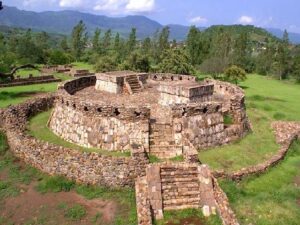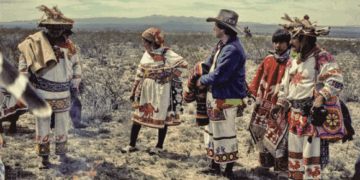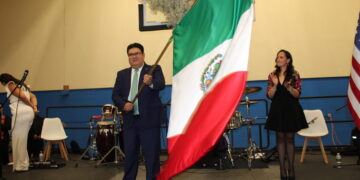The Téenek are an indigenous people descended from the Maya who live in the Mexican states of San Luis Potosí, Veracruz, Hidalgo, Puebla, and Tamaulipas, in a region known in Mexico as La Huasteca. Their native language is the Huastec language.
Today’s Huastecos are descendants of the bearers of the pre-Columbian Huastec culture, and since the time before the arrival of the Spanish, they have shared their ethnic territory with other groups, especially the Nahua.
Speaking of this people, Fray Bernardino de Sahagún says: “The name of all these people comes from the province called Cuextlan, where the inhabitants are called ‘Cuextecas.'”

Téenek Embroidery
The Téenek are known for their embroidery with geometric figures that represent life. The Téenek star represents the four cardinal points. Téenek embroidery is done with a type of double cross stitch.
The most important colors are red, which represents the North, the protection and wisdom of the father and grandfather; yellow-orange, associated with the East, symbolizes the light of the sun that illuminates the universe; the light of sunrise is yellow; and the light of sunset is orange; green is the color of the soul, of the spirit that emerges from the body, and is linked to the West; and bright pink is the vivid color of love, of origin, of Mother Earth, of taste, of the generous Téenek spirit, and of the affection between man and woman.
The Téenek star is the most common and representative figure in Téenek embroidery, and when the trace of an S can be found within it, it represents corn, so important in Téenek culture and associated with the colors red and yellow.
Animals can also be found in Téenek embroidery, the most frequently depicted being the heron, the duck, the hare, the deer, the lark, the badger, among others.
Tamtok Ruins: Tamuín, San Luis Potosí
Tamtoc, Tamtok, or Tamohí (Teenek for “place of water clouds”) is an archaeological site of the Huastec culture. It is located in the municipality of Tamuín in the Mexican state of San Luis Potosí, in what is now known as the Huasteca region.
Since 2000, it has been improved and restored by a team of professionals, with archaeologist Estela Martínez Mora in charge of the on-site studies. The archaeological zone is representative of the Huastec culture of the final centuries of pre-Hispanic Mexico and is located on the northern edge of the Mesoamerican cultural super-area.
With an area of approximately 210 hectares, it can be said that Tamtoc was one of the most important Huastec urban centers of the late pre-Hispanic period due to its size and characteristics. Its development lasted only a few centuries before the arrival of the Spanish, until its sudden abandonment in the 16th century. It is located on the northeast bank of the Tampaón River, part of the Pánuco River hydraulic system.
One of the distinguishing characteristics of Tamtoc is the notable presence of women. To date, 90% of the burials discovered there are women. Furthermore, they are represented in most of the clay and ceramic figurines found here, and it is believed that they held a high rank in the community’s social structure.
Huastecos Téenek
Los Téenek son un pueblo indígena descendiente de los mayas que habitan en los estados mexicanos de San Luis Potosí, Veracruz, Hidalgo, Puebla y Tamaulipas, en una región que en México es conocida como La Huasteca. La lengua nativa de este pueblo es el idioma huasteco.
Los huastecos actuales son descendientes de los portadores de la cultura huasteca precolombina, y desde la época anterior a la llegada de los españoles comparten su territorio étnico con otros grupos, especialmente los nahuas.
Hablando de este pueblo Fray Bernardino de Sahagún dice: “El nombre de todos estos tomase de la provincia que llaman Cuextlan, donde los que están poblados se llaman “Cuextecas”.
Bordado Téenek
Los Téenek son conocidos por sus bordados con figuras geométricas que representan la vida. La estrella Téenek representa los cuatro puntos cardinales. El bordado Téenek se hace con un tipo de punto de cruz doble.
Los colores más importantes son el rojo que representa el Norte, la protección y sabiduría del padre y abuelo; el amarillo-naranja asociado al Este, simboliza la luz del sol que ilumina el universo, la luz del amanecer amarilla y la del atardecer naranja; el verde es el color del alma, del espíritu que se desprende del cuerpo, está vinculado al Oeste; y el rosa brillante es el color vivo del amor, del origen, de la madre Tierra, el gusto, el espíritu generoso Téenek, el cariño entre el hombre y la mujer.
La estrella Téenek es la figura más común y representativa del bordado Téenek y cuando dentro de ésta se puede encontrar el trazo de una S, es el maíz, tan importante en la cultura Téenek y que se asocia al color rojo y amarillo.
En los bordados Téenek también se puede encontrar animales, los que se representan con mayor frecuencia son la garza, el pato, la liebre, el venado, la calandria, el tejón, entre otros. 
Ruinas de Tamtok: Tamuín, San Luis Potosí
Tamtoc, Tamtok o Tamohí (téenek para “lugar de las nubes de agua”) es un yacimiento arqueológico de la cultura huasteca, se encuentra en el municipio de Tamuín en el estado mexicano de San Luis Potosí, en lo que hoy en día se conoce como la región Huasteca.
Desde el 2000 ha sido mejorado y recuperado por un equipo de profesionales, siendo la arqueóloga Estela Martínez Mora la encargada de los estudios en el sitio. La zona arqueológica es representativa de la cultura huasteca de los últimos siglos del México prehispánico, y se encuentra situada en el límite norte de la super área cultural mesoamericana.
Con una extensión de cerca de 210 hectáreas, se puede asegurar que Tamtoc fue uno de los centros urbanos huastecos más importantes del último periodo prehispánico por sus dimensiones y características. Su desarrollo duró pocos siglos antes de que los españoles llegaran, hasta su repentino abandono en el siglo XVI. Se localiza en la ribera noreste del río Tampaón, parte del sistema hidráulico del río Pánuco.
Una de las características que distinguen a Tamtoc es la notable presencia femenina. A la fecha el 90% de los entierros ahí descubiertos son de mujeres. Además, están representadas en la mayoría de las figurillas de arcilla y cerámica aquí encontradas y que se piensa tenían un alto rango en la división social de la comunidad.













































